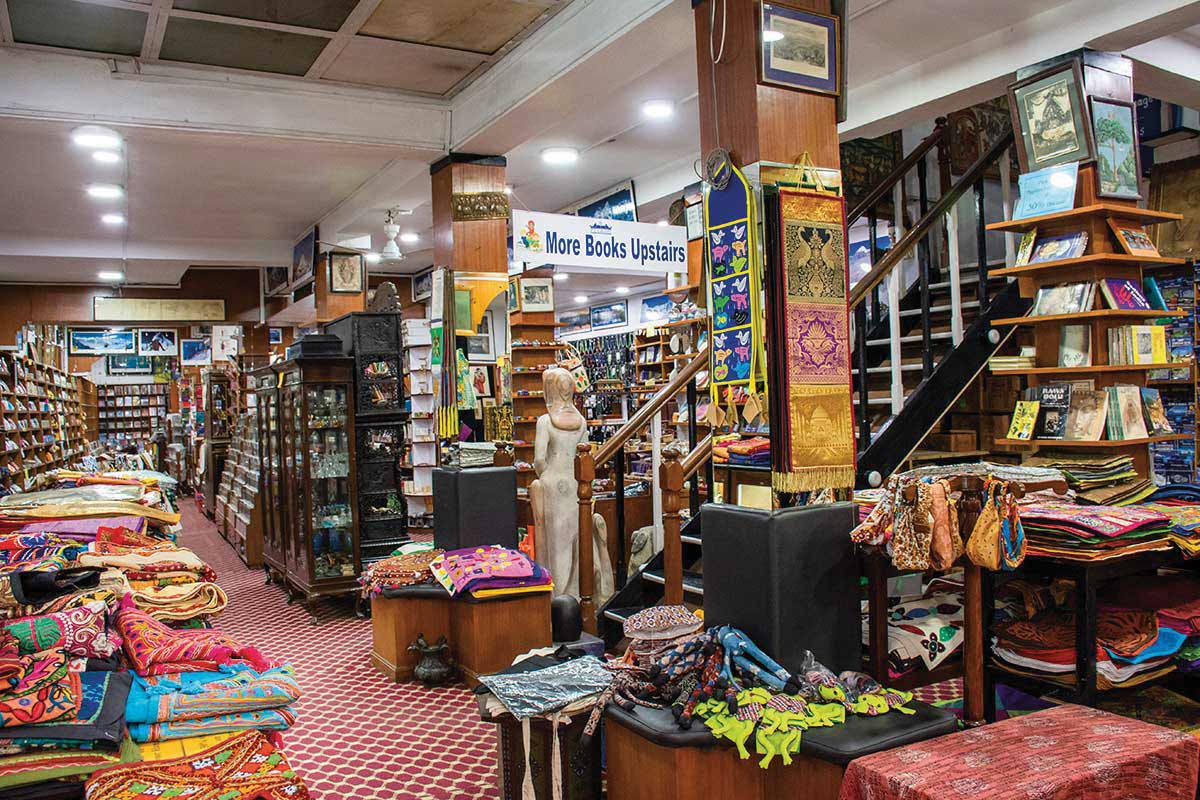A truly Nepali fabric, ‘dhaka’ belongs to a different, charmed time in Nepal.
A friend of mine upon visiting Nepal remarked that we seem to have a national ‘everything’. Animals, birds, weapons, dresses, games; we seem to have it all. Yet amidst this list, Dhaka fabric misses mention, despite being undoubtedly Nepali and defining Nepal more than any other fabric.
 Recognized only as a shadow of its true self, today it is probably best known in the form of a Dhaka topi (cap) – a symbol and part of the face of Nepal and Nepali men. The topi is a mixture of elegance and tradition, and of national heritage, as it carries with it a legacy expressed with a simple headgear. And, there is the Dhaka ko Khasto, a shawl, a truly Nepali shawl.
Recognized only as a shadow of its true self, today it is probably best known in the form of a Dhaka topi (cap) – a symbol and part of the face of Nepal and Nepali men. The topi is a mixture of elegance and tradition, and of national heritage, as it carries with it a legacy expressed with a simple headgear. And, there is the Dhaka ko Khasto, a shawl, a truly Nepali shawl.
Dhaka gives me this old romantic impression of Nepal maybe a hundred years ago – and I wasn’t born a hundred years ago so I don’t know – but it is this feeling, an impression of a more and truly cultured Nepal, bearing its own unique, untainted identity, unaffected by the waves of foreign influence in fashion and culture. Like old Nepali houses, like old timeless traditions, like old works of art that are scattered across Nepal – Dhaka belongs there. It belongs in ancient black and white and sepia toned family photographs of grandmothers and grandfathers, with her wearing a dhaka ko cholo and khasto and him wearing a dhaka ko topi. Nepal is a different place in many ways now and these days the fabric makes an appearance mainly at weddings; the fashion of bridegrooms dressing in full dhaka attire – daura surwal (tunic and leggings) and topi and chatti (slippers, yes) being quite popular. Being the choice fabric for such an important day does hint to the true significance of the fabric – significance steeped in history and art, a proud tradition and heritage, and well and truly, a symbol of Nepal. It was the fabric of Nepal. Its value may be a little tarnished due to neglect and the takeover by countless fashion trends, brands and shopping centres and many more but a man wearing a Dhaka ko topi, or women in Dhaka attire will always unmistakably bring to surface the Nepali identity.
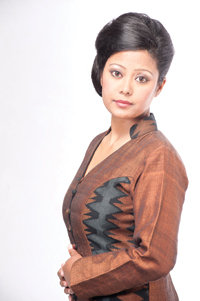 The history of Dhaka, a story in itself is part of an inherent timeless yet forgotten story. Before the fancy shops selling labels in Durbar Marg or the shopping malls, supermarkets and clothing stores that dress Nepal in all things ‘imported’, before the pedlars on the sidewalks and footpaths selling clothes, there was, and still is in some parts of Nepal an almost forgotten practise – homespun.
The history of Dhaka, a story in itself is part of an inherent timeless yet forgotten story. Before the fancy shops selling labels in Durbar Marg or the shopping malls, supermarkets and clothing stores that dress Nepal in all things ‘imported’, before the pedlars on the sidewalks and footpaths selling clothes, there was, and still is in some parts of Nepal an almost forgotten practise – homespun.
Charkhas, Taans – the spinning wheel and the weaving loom. Back to the basics. Cloth woven from hand spun thread, which in turn is sourced from cotton grown locally. It’s easy these days to take for granted how clothes and everything else is made. Cloth is woven from thread that comes from cotton, or a range of synthetic materials these days. Before the advent of the power looms, when everything was done by hand, making clothes was a skilled thing to do and cloth in itself was valuable.
Dhaka in particular was more than just cloth. It was special, extra special. It featured colours, designs and prints, which while taken for granted today were things of significance then. The use of dyed threads, its signature patterns – all achieved by hand weaving required great skill and was extremely tedious. Today this makes it a part of the past; in the past, it was a thing of wonder.
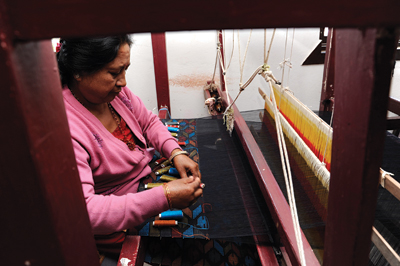 The origin of dhaka goes back several hundred years. Palpa and Tehrathum are the two most noted places regarding its origins, Palpali dhaka being a well-known product line in Nepal. However there are many places around Nepal that make dhaka products today with commercial production starting in Tansen, Palpa around 50 years ago. There is a little misconception about dhaka coming from the name of the place –the current capital of Bangladesh, which was, in times of the British regime in India, a place renowned for its textile production. The misconception seems to stem from the obvious – the name, and can be discarded given that the origins of the fabric are much older. Its origins can be better associated with women of the Rai and Limbu castes, who continue to make it these days, their efforts dedicated to preserving the form of art and way of life that dhaka is.
The origin of dhaka goes back several hundred years. Palpa and Tehrathum are the two most noted places regarding its origins, Palpali dhaka being a well-known product line in Nepal. However there are many places around Nepal that make dhaka products today with commercial production starting in Tansen, Palpa around 50 years ago. There is a little misconception about dhaka coming from the name of the place –the current capital of Bangladesh, which was, in times of the British regime in India, a place renowned for its textile production. The misconception seems to stem from the obvious – the name, and can be discarded given that the origins of the fabric are much older. Its origins can be better associated with women of the Rai and Limbu castes, who continue to make it these days, their efforts dedicated to preserving the form of art and way of life that dhaka is.
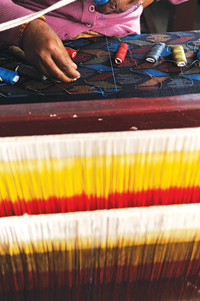 Dhaka like most things has seen changes over time, and the methods of production involved in its making as well as the raw materials that go into it have changed slowly too. Originally made entirely by hand from mercerized cotton that was spun into raw yarn which in turn was dyed and then woven in hand looms called ‘Haate taan’, these days there are factories where everything is automated and instead of being made purely from cotton, synthetics such as polyester are used. There are trade-offs between the use of machinery and pure human effort for modern looms such as the Jacquard looms that boost productivity significantly.
Dhaka like most things has seen changes over time, and the methods of production involved in its making as well as the raw materials that go into it have changed slowly too. Originally made entirely by hand from mercerized cotton that was spun into raw yarn which in turn was dyed and then woven in hand looms called ‘Haate taan’, these days there are factories where everything is automated and instead of being made purely from cotton, synthetics such as polyester are used. There are trade-offs between the use of machinery and pure human effort for modern looms such as the Jacquard looms that boost productivity significantly.
It’s worth mentioning that there is real Dhaka and the print Dhaka. Later advancements in technology allowed for easier, cheaper and simpler means of production of types of fabric other than Dhaka that imitated the look of the original dhaka print. It was imitation in the form of flattery, and not a con, for the difference is obvious to anyone and everyone - patterns and prints in dhaka are woven into the fabric while the imitations had colour dyed into the final fabric. There is a silent understanding now and both the real and the print are called dhaka, the latter a favourite in making things such as summer blankets, cholo (blouse), bhotto (the Nepali version of thermals) and many more.
The look of dhaka has demands both in Nepal and abroad. Nationally there are constant demands caused by the traditions associated with dhaka – festivals, religious and social occasions while for foreign markets, the fabric exudes a uniquely exotic and Nepali look making it an excellent product for export as traditional handicraft.
Dhaka is extremely versatile and can be used to make many things. Its use and export is not limited to clothing alone such as shawls but has been expanded into making ties and a whole range of cookware such as aprons, oven mitts and potholders as well as cases for mobile phones and such.
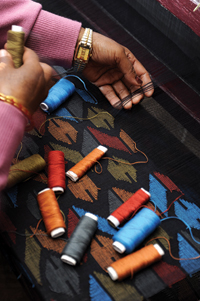 If you need another reason to wear something made of dhaka consider that its usually women’s groups who make it, supporting the craft in itself as well as their families. Various groups helping and training each other is one of the ways dhaka is still here today. Its presence is here but only in traces and almost all the shops that sell dhaka in Kathmandu are concentrated in Indra Chowk, five minutes from Basantapur Durbar Sqaure.
If you need another reason to wear something made of dhaka consider that its usually women’s groups who make it, supporting the craft in itself as well as their families. Various groups helping and training each other is one of the ways dhaka is still here today. Its presence is here but only in traces and almost all the shops that sell dhaka in Kathmandu are concentrated in Indra Chowk, five minutes from Basantapur Durbar Sqaure.
The value of dhaka, for as much as part of Nepal and Nepali culture that it is, is in limbo, caught up in the odd change of fashion. It doesn’t quite blend in with modern fashion due to its traditional impression but it is certainly of a greater potential than has been realized. But it is unique, it is Nepali.
So the next time you see dhaka – remember, it’s more than a fabric – it’s a piece of history, culture and tradition. Something old, and like so many aspects of our culture, it is in need of revival and recognition. So who is going to write to Prabal Gurung about using dhaka in his next set of designs?



